Jimmy Lin
Study on LLMs for Promptagator-Style Dense Retriever Training
Oct 02, 2025Abstract:Promptagator demonstrated that Large Language Models (LLMs) with few-shot prompts can be used as task-specific query generators for fine-tuning domain-specialized dense retrieval models. However, the original Promptagator approach relied on proprietary and large-scale LLMs which users may not have access to or may be prohibited from using with sensitive data. In this work, we study the impact of open-source LLMs at accessible scales ($\leq$14B parameters) as an alternative. Our results demonstrate that open-source LLMs as small as 3B parameters can serve as effective Promptagator-style query generators. We hope our work will inform practitioners with reliable alternatives for synthetic data generation and give insights to maximize fine-tuning results for domain-specific applications.
MAGMaR Shared Task System Description: Video Retrieval with OmniEmbed
Jun 11, 2025Abstract:Effective video retrieval remains challenging due to the complexity of integrating visual, auditory, and textual modalities. In this paper, we explore unified retrieval methods using OmniEmbed, a powerful multimodal embedding model from the Tevatron 2.0 toolkit, in the context of the MAGMaR shared task. Evaluated on the comprehensive MultiVENT 2.0 dataset, OmniEmbed generates unified embeddings for text, images, audio, and video, enabling robust multimodal retrieval. By finetuning OmniEmbed with the combined multimodal data--visual frames, audio tracks, and textual descriptions provided in MultiVENT 2.0, we achieve substantial improvements in complex, multilingual video retrieval tasks. Our submission achieved the highest score on the MAGMaR shared task leaderboard among public submissions as of May 20th, 2025, highlighting the practical effectiveness of our unified multimodal retrieval approach. Model checkpoint in this work is opensourced.
On the Comprehensibility of Multi-structured Financial Documents using LLMs and Pre-processing Tools
Jun 05, 2025Abstract:The proliferation of complex structured data in hybrid sources, such as PDF documents and web pages, presents unique challenges for current Large Language Models (LLMs) and Multi-modal Large Language Models (MLLMs) in providing accurate answers. Despite the recent advancements of MLLMs, they still often falter when interpreting intricately structured information, such as nested tables and multi-dimensional plots, leading to hallucinations and erroneous outputs. This paper explores the capabilities of LLMs and MLLMs in understanding and answering questions from complex data structures found in PDF documents by leveraging industrial and open-source tools as part of a pre-processing pipeline. Our findings indicate that GPT-4o, a popular MLLM, achieves an accuracy of 56% on multi-structured documents when fed documents directly, and that integrating pre-processing tools raises the accuracy of LLMs to 61.3% for GPT-4o and 76% for GPT-4, and with lower overall cost. The code is publicly available at https://github.com/OGCDS/FinancialQA.
Improving Multilingual Math Reasoning for African Languages
May 26, 2025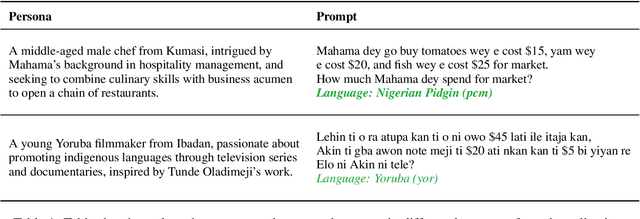
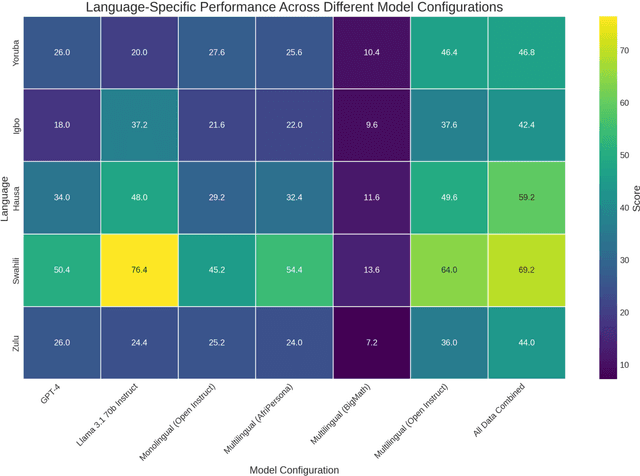
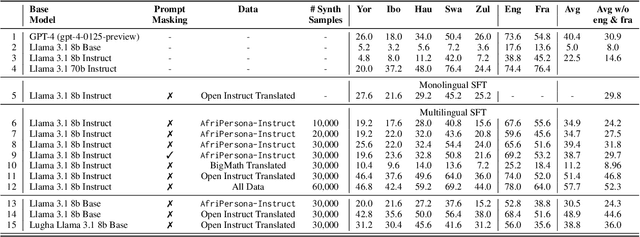

Abstract:Researchers working on low-resource languages face persistent challenges due to limited data availability and restricted access to computational resources. Although most large language models (LLMs) are predominantly trained in high-resource languages, adapting them to low-resource contexts, particularly African languages, requires specialized techniques. Several strategies have emerged for adapting models to low-resource languages in todays LLM landscape, defined by multi-stage pre-training and post-training paradigms. However, the most effective approaches remain uncertain. This work systematically investigates which adaptation strategies yield the best performance when extending existing LLMs to African languages. We conduct extensive experiments and ablation studies to evaluate different combinations of data types (translated versus synthetically generated), training stages (pre-training versus post-training), and other model adaptation configurations. Our experiments focuses on mathematical reasoning tasks, using the Llama 3.1 model family as our base model.
RankLLM: A Python Package for Reranking with LLMs
May 25, 2025Abstract:The adoption of large language models (LLMs) as rerankers in multi-stage retrieval systems has gained significant traction in academia and industry. These models refine a candidate list of retrieved documents, often through carefully designed prompts, and are typically used in applications built on retrieval-augmented generation (RAG). This paper introduces RankLLM, an open-source Python package for reranking that is modular, highly configurable, and supports both proprietary and open-source LLMs in customized reranking workflows. To improve usability, RankLLM features optional integration with Pyserini for retrieval and provides integrated evaluation for multi-stage pipelines. Additionally, RankLLM includes a module for detailed analysis of input prompts and LLM responses, addressing reliability concerns with LLM APIs and non-deterministic behavior in Mixture-of-Experts (MoE) models. This paper presents the architecture of RankLLM, along with a detailed step-by-step guide and sample code. We reproduce results from RankGPT, LRL, RankVicuna, RankZephyr, and other recent models. RankLLM integrates with common inference frameworks and a wide range of LLMs. This compatibility allows for quick reproduction of reported results, helping to speed up both research and real-world applications. The complete repository is available at rankllm.ai, and the package can be installed via PyPI.
Conventional Contrastive Learning Often Falls Short: Improving Dense Retrieval with Cross-Encoder Listwise Distillation and Synthetic Data
May 25, 2025Abstract:We investigate improving the retrieval effectiveness of embedding models through the lens of corpus-specific fine-tuning. Prior work has shown that fine-tuning with queries generated using a dataset's retrieval corpus can boost retrieval effectiveness for the dataset. However, we find that surprisingly, fine-tuning using the conventional InfoNCE contrastive loss often reduces effectiveness in state-of-the-art models. To overcome this, we revisit cross-encoder listwise distillation and demonstrate that, unlike using contrastive learning alone, listwise distillation can help more consistently improve retrieval effectiveness across multiple datasets. Additionally, we show that synthesizing more training data using diverse query types (such as claims, keywords, and questions) yields greater effectiveness than using any single query type alone, regardless of the query type used in evaluation. Our findings further indicate that synthetic queries offer comparable utility to human-written queries for training. We use our approach to train an embedding model that achieves state-of-the-art effectiveness among BERT embedding models. We release our model and both query generation and training code to facilitate further research.
Fixing Data That Hurts Performance: Cascading LLMs to Relabel Hard Negatives for Robust Information Retrieval
May 22, 2025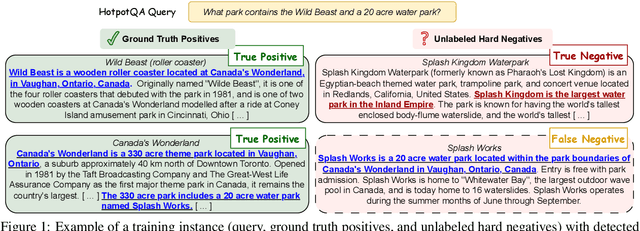
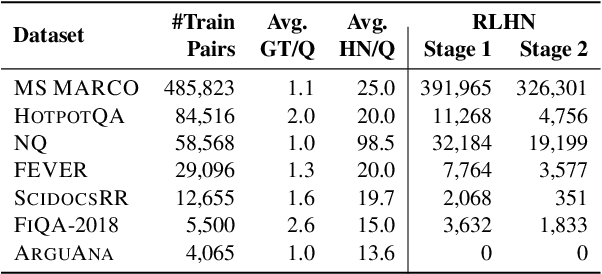

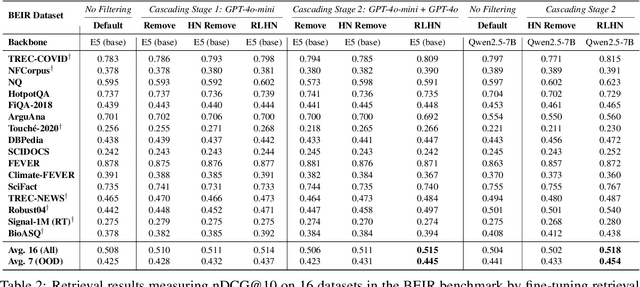
Abstract:Training robust retrieval and reranker models typically relies on large-scale retrieval datasets; for example, the BGE collection contains 1.6 million query-passage pairs sourced from various data sources. However, we find that certain datasets can negatively impact model effectiveness -- pruning 8 out of 15 datasets from the BGE collection reduces the training set size by 2.35$\times$ and increases nDCG@10 on BEIR by 1.0 point. This motivates a deeper examination of training data quality, with a particular focus on "false negatives", where relevant passages are incorrectly labeled as irrelevant. We propose a simple, cost-effective approach using cascading LLM prompts to identify and relabel hard negatives. Experimental results show that relabeling false negatives with true positives improves both E5 (base) and Qwen2.5-7B retrieval models by 0.7-1.4 nDCG@10 on BEIR and by 1.7-1.8 nDCG@10 on zero-shot AIR-Bench evaluation. Similar gains are observed for rerankers fine-tuned on the relabeled data, such as Qwen2.5-3B on BEIR. The reliability of the cascading design is further supported by human annotation results, where we find judgment by GPT-4o shows much higher agreement with humans than GPT-4o-mini.
Don't "Overthink" Passage Reranking: Is Reasoning Truly Necessary?
May 22, 2025Abstract:With the growing success of reasoning models across complex natural language tasks, researchers in the Information Retrieval (IR) community have begun exploring how similar reasoning capabilities can be integrated into passage rerankers built on Large Language Models (LLMs). These methods typically employ an LLM to produce an explicit, step-by-step reasoning process before arriving at a final relevance prediction. But, does reasoning actually improve reranking accuracy? In this paper, we dive deeper into this question, studying the impact of the reasoning process by comparing reasoning-based pointwise rerankers (ReasonRR) to standard, non-reasoning pointwise rerankers (StandardRR) under identical training conditions, and observe that StandardRR generally outperforms ReasonRR. Building on this observation, we then study the importance of reasoning to ReasonRR by disabling its reasoning process (ReasonRR-NoReason), and find that ReasonRR-NoReason is surprisingly more effective than ReasonRR. Examining the cause of this result, our findings reveal that reasoning-based rerankers are limited by the LLM's reasoning process, which pushes it toward polarized relevance scores and thus fails to consider the partial relevance of passages, a key factor for the accuracy of pointwise rerankers.
Benchmarking LLM Faithfulness in RAG with Evolving Leaderboards
May 07, 2025


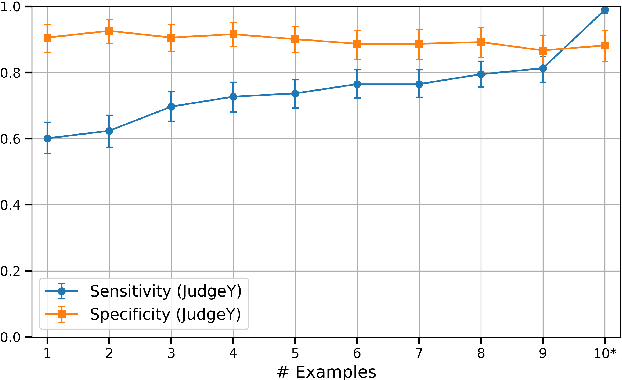
Abstract:Hallucinations remain a persistent challenge for LLMs. RAG aims to reduce hallucinations by grounding responses in contexts. However, even when provided context, LLMs still frequently introduce unsupported information or contradictions. This paper presents our efforts to measure LLM hallucinations with a focus on summarization tasks, assessing how often various LLMs introduce hallucinations when summarizing documents. We discuss Vectara's existing LLM hallucination leaderboard, based on the Hughes Hallucination Evaluation Model (HHEM). While HHEM and Vectara's Hallucination Leaderboard have garnered great research interest, we examine challenges faced by HHEM and current hallucination detection methods by analyzing the effectiveness of these methods on existing hallucination datasets. To address these limitations, we propose FaithJudge, an LLM-as-a-judge approach guided by few-shot human hallucination annotations, which substantially improves automated LLM hallucination evaluation over current methods. We introduce an enhanced hallucination leaderboard centered on FaithJudge, alongside our current hallucination leaderboard, enabling more reliable benchmarking of LLMs for hallucinations in RAG.
Tevatron 2.0: Unified Document Retrieval Toolkit across Scale, Language, and Modality
May 05, 2025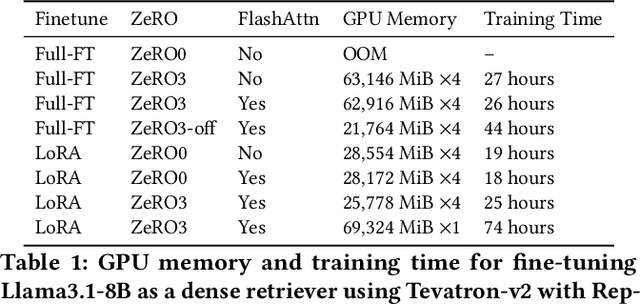
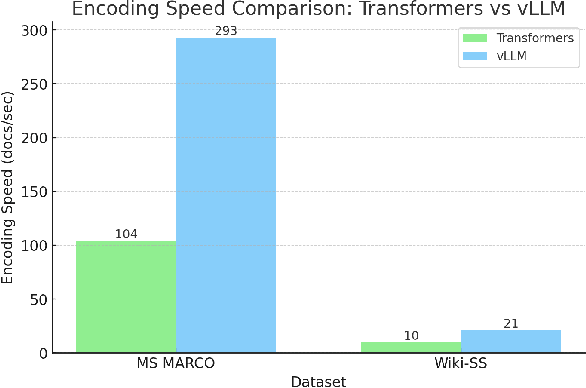
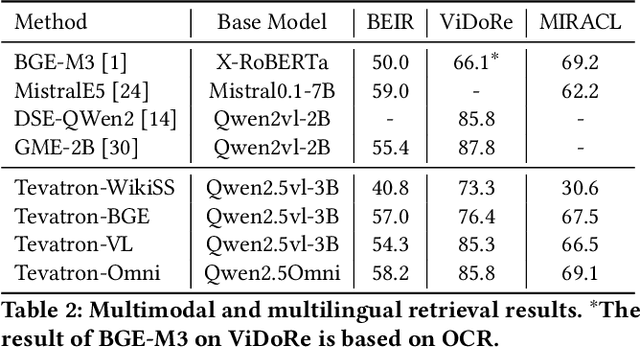
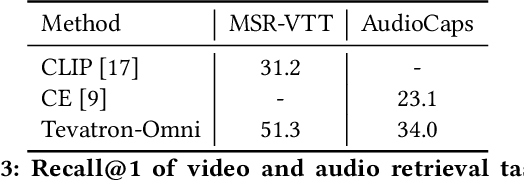
Abstract:Recent advancements in large language models (LLMs) have driven interest in billion-scale retrieval models with strong generalization across retrieval tasks and languages. Additionally, progress in large vision-language models has created new opportunities for multimodal retrieval. In response, we have updated the Tevatron toolkit, introducing a unified pipeline that enables researchers to explore retriever models at different scales, across multiple languages, and with various modalities. This demo paper highlights the toolkit's key features, bridging academia and industry by supporting efficient training, inference, and evaluation of neural retrievers. We showcase a unified dense retriever achieving strong multilingual and multimodal effectiveness, and conduct a cross-modality zero-shot study to demonstrate its research potential. Alongside, we release OmniEmbed, to the best of our knowledge, the first embedding model that unifies text, image document, video, and audio retrieval, serving as a baseline for future research.
 Add to Chrome
Add to Chrome Add to Firefox
Add to Firefox Add to Edge
Add to Edge